Beyond the pyramid ramp: Unravelling Egypt’s most elusive enigma
The mystery of how the Pyramids of Giza in Egypt were built continues to elude scholars, even in the 21 st century. As famed Egyptologist Flinders Petrie records in his The Pyramids and Temples of Gizeh (1883): “The means employed for raising such masses of stone is not shown to us in any representations.” The brightest minds in the world still wrestle with competing ideas, offering educated guesses based on incomplete evidence.
Every theory begins with the inclined plane, or the pyramid ramp. This idea was first mentioned two millennia ago by the Greek historian Diodorus Siculus, who recounted what the Egyptians told him about the pyramids: "It is said that … the construction was undertaken with the help of ramps of earth, since at that time cranes had not yet been invented." (Library of History 1. 63).
Many Theories for the Pyramid Ramp
By the end of the 19 th century, Petrie had carefully measured the Pyramids of Giza , particularly the Great Pyramid of Khufu, and determined that the likeliest manner of their construction was using a single, long ramp, with a smaller zig-zag ramp near the summit. Since then, this idea has largely been discredited due to lack of evidence, and other theories have taken its place.
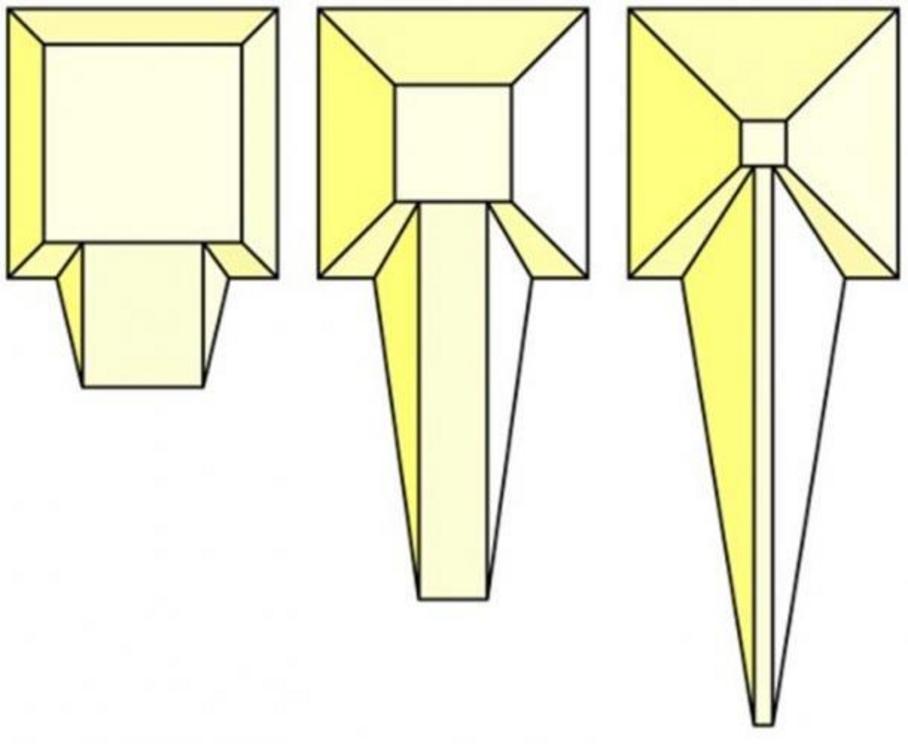
Three types of single, straight pyramid ramps to build that could have been used in the construction of the ancient site. (Smuckola / CC BY-SA 4.0 )
Late German Egyptologist Uvo Hölscher believed the Egyptians employed a short ramp that zig-zagged all the way up the face of the pyramid, while Dieter Arnold, the German archaeologist who wrote the famous Building in Egypt (1991) believes a long ramp was used, but that it cut through the center of and was partially composed of the pyramid itself.
Meanwhile, Giza archaeologists Zahi Hawass and Mark Lehner believe the material evidence most clearly points to a spiral ramp that would have twisted up the exterior of the pyramid, either resting against the structure or on a large earthen mound. They suggest that water or milk would have been used to lubricate wooden sleds strapped with stone blocks, similar to a scene from the Middle Kingdom tomb of Djehuti-hotep (~1900 BC).
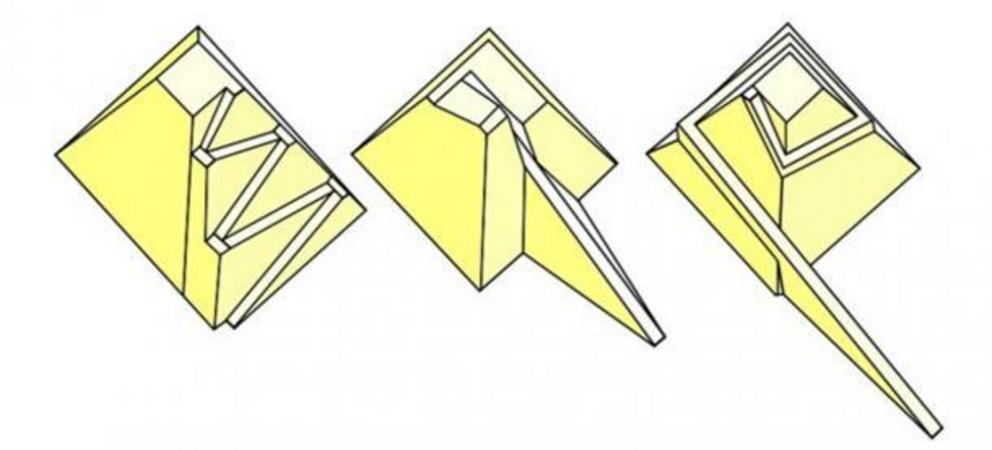
Three different pyramid ramp proposals, by Uvo Hölsher (left), Dieter Arnold (center) and Mark Lehner (right). (Althiphika / CC BY-SA 3.0 )
Numerous recent experiments have confirmed this possibility, including a study in 2014 by Daniel Bonn and other scientists from the FOM Foundation and the University of Amsterdam that demonstrated the right proportion of water on sand could reduce the required people hauling a block by half. There is also a depiction on a New Kingdom stela showing six oxen pulling a block on a sled (~1575 BC), and many actual sleds have been recovered.
What About the Evidence?
Evidence of earth ramps do exist in Egypt. The best example comes from the Temple of Karnak at Thebes, where it can be found still leaning against the back of the towering First Pylon. Made of mud brick, it was never completely disassembled, and it stands today as testament to the manner in which these large stone structures were built and decorated. Further examples come from the abandoned step pyramid of Sinki at Abydos. Likely built by Huni, Sneferu’s father and Khufu’s grandfather, this pyramid has four construction ramps still in place, composed of two outer mud-brick walls with an interior fill of debris and stone chips.
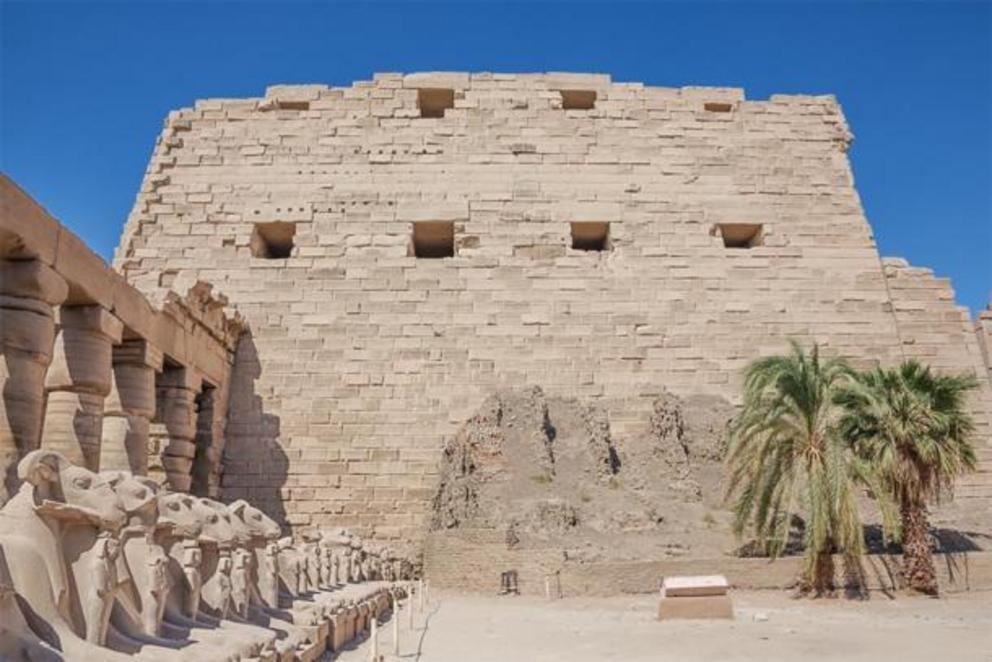
Remains of an ancient mud-brick ramp at the Temple of Karnak at Thebes (First Pylon, New Kingdom). ( Vermeulen-Perdaen / Adobe stock)
Amazingly, the potential construction ramp of the Great Pyramid has already been discovered, and it was similar to these other ramps. In 1995, the Giza Inspectorate “excavated trenches through thick layers of limestone debris south of the southwest corner of Khufu’s pyramid. Remains of fieldstone walls were found running north-northwest that could have been the accretions or retaining walls of the foundation of (such) a supply ramp.” (Lehner, 2017; 440).
According to Hawass, this lower section of the ramp: “consisted of two walls built of stone rubble and mixed with “tafla” (a calcareous clay). The area in between was filled with sand and gypsum forming the bulk of the ramp.” (Hawass, 1998; 58). He calculated the ramp would have reached ~30m (98ft) above the pyramid’s base, or roughly 20% of the pyramid’s original total height of 146.7m (481.3ft). Beyond that he believes the ramp would have spiraled up the exterior of the structure.
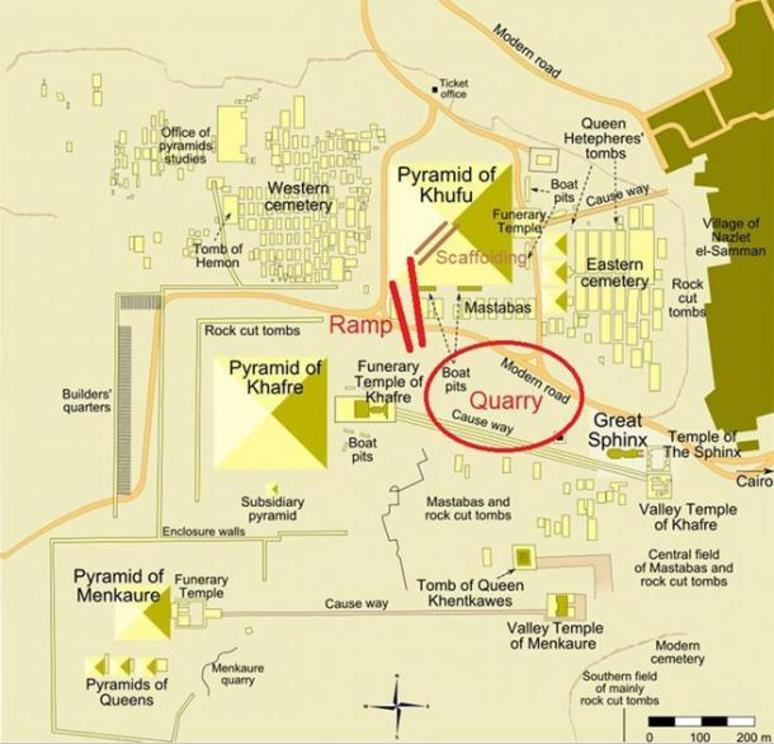
Map of the Giza Plateau, showing newly-discovered ancient ramp in red line at southwest corner of Khufu’s pyramid, and quarry and authors’ proposed wooden scaffolding running up to the top (red and brown lines added by author). (MesserWolland / CC BY-SA 3.0 )
In late 2018, the remains of a ramp were found in the ancient alabaster quarry at Hatnub, from the very time of Khufu. It reveals how the Egyptians could have moved tremendously heavy blocks of stone by using physics to aid them. Archaeologists from the French Institute for Oriental Archaeology and the University of Liverpool excavated a ramp with flights of stairs on either side, and with post-holes near the stairs running all the way up the ramp.
It has been suggested by the excavating team that by using ropes tied around wooden posts, ancient workers could have hauled large blocks much easier by using gravity to pull down rather than pulling up. They could also control the blocks better, which are imagined as having rested on wooden sleds attached to the ropes.
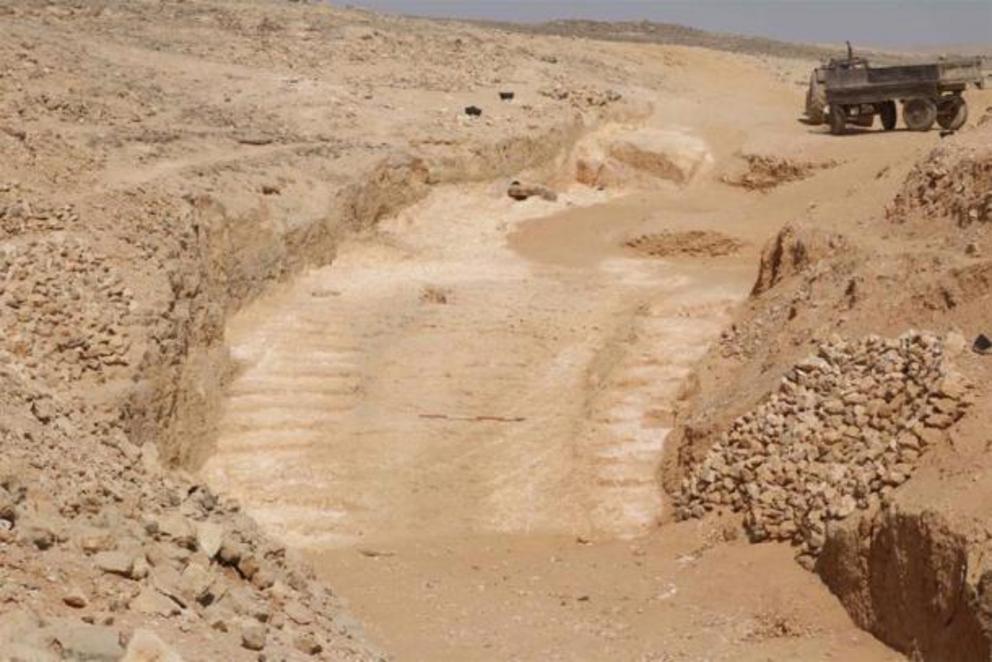
Ancient ramp discovered at Hatnub, Eastern Egypt, in 2018, similar in shape but smaller in dimensions than the pyramid ramps that could have been used to build the contemporaneous site at Giza. (Yannis Gourdon / IFAO)
The addition of ropes and wooden poles to change the direction of force could have effectively doubled the ramp grade, meaning any ramps on the pyramids would have only needed to have been half their projected size. This could have potentially doubled the grade of Khufu’s ramp, discovered in 1995, up to ~60m (197ft), or 40% of the pyramid’s original height (and most of the volume).
However, problems persist. A ramp that spiraled around the pyramid would be impractical because of the inability to back-sight each corner to remain true, its massive size (rivalling the pyramid itself), and the lack of any archaeological evidence. So if the builders did use a ramp, where was it? An ingenious architect named Jean-Pierre Houdin thought he had the answer.
A Hidden Ramp Inside
Perhaps no other theory in recent years has garnered as much attention as that of the Great Pyramid’s supposed ‘internal ramp’, an idea first proposed by the French architect Jean-Pierre Houdin in 2005. Aided in his exploration by Egyptologist Bob Brier, they flew to Egypt to hunt for evidence of this proposed inside-ramp.
In essence, Houdin proposed that the Egyptians had built an internal ramp just inside the perimeter of the structure that wound its way up as the pyramid rose, composed of corbelled ceilings and corner notches in which the blocks would be rotated on rope cranes. This would seemingly eliminate the need for external ramps, levers, cranes or scaffolding.
Several lines of evidence jumped out at the researchers as proof of their idea. First, Houdin detected faint ‘phantom’ lines within the masonry of the pyramid that ran at ~7°, the exact angle he determined the internal ramp must run at.
Second, there is a mysterious ‘notch’ on the northeastern edge of the pyramid, where Houdin had predicted was an original ‘corner block-turning station’. This ‘notch’ was explored by Brier, who found a small irregular chamber (‘Bob’s Room’) but nothing more.
Third, in 1986 a French team completed a microgravimetric study of the pyramid, and the resultant CG-image of low- and high-density areas revealed an image consistent with an internal ramp.
Attractive Theory But Where is the Evidence?
Despite how attractive this theory seemed at first, many noted it was an unlikely scenario. Egyptologist David Jeffreys called it “far-fetched and horribly complicated,” for it proposed the pyramid is vastly more complicated than presently believed. Instead of having four internal chambers and corridors, it would actually have the equivalent of dozens of internal chambers. Instead of having one impressive and corbelled Grand Gallery, it would have the equivalent of over thirty grand galleries winding up through the monument, all corbelled corridors of impressive masonry.
It seems absurd, considering how amazing a feat the Grand Gallery itself was, that there would still be thirty more of them to discover somewhere inside the pyramid, all connected together. And despite much indirect evidence, Brier and Houdin have not found any specific hard data for their ramp. Even their much-lauded microgravimetric scan could be interpreted differently, such as via the model of internal ‘steps’.
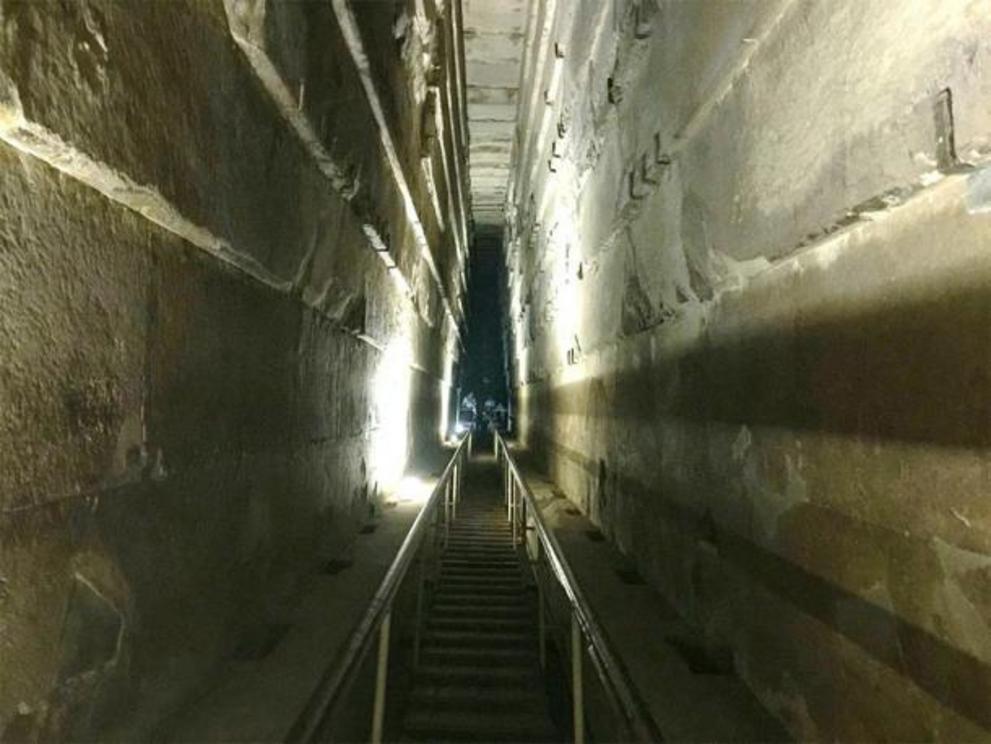
The Grand Gallery in the Great Pyramid of Giza. Houdin’s theory would require another 30 of these inside the pyramid. (Keith Adler / CC BY-SA 4.0 )
Now, despite the difficulties with the idea, it remained a promising theory in need of independent verification. Fortunately, the ‘Scan Pyramids Mission’ ( scanpyramids.org) would be its ultimate test. Beginning in 2015, this study was based on the idea of using cosmic particles called muons to remotely scan the pyramid for void spaces, an idea first employed by famed physicist Luis Alvarez in the late 1960s on Khafre’s pyramid.
Large collectors were set up in the Great Pyramid and the muons that streamed through the structure were measured in the hopes of identifying any hidden chambers. The idea that a beautiful internal passageway snaking up through the structure would be revealed had millions of excited archaeology buffs on the edge of their seats. Then the results came in.
While a large void was detected above the Grand Gallery, no internal ramp was detected. Nada. This deflationary news was relayed by the theory’s first expert supporter, Bob Brier himself: “these data suggest that the ramp is not there. I think we’ve lost.” So if there was no internal ramp inside the Great Pyramid, then how was it actually built? How were the stones lifted skyward hundreds of feet, beyond the ramp?
For the rest of this story please use source link below

